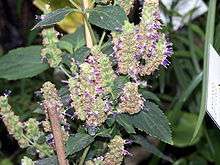Patchouli
| Patchouli | |
|---|---|
 | |
| Scientific classification | |
| Kingdom: | Plantae |
| (unranked): | Angiosperms |
| (unranked): | Eudicots |
| (unranked): | Asterids |
| Order: | Lamiales |
| Family: | Lamiaceae |
| Genus: | Pogostemon |
| Species: | P. cablin |
| Binomial name | |
| Pogostemon cablin (Blanco) Benth. | |
Patchouli[note 1] (Pogostemon cablin (Blanco) Benth) is a species of plant from the genus Pogostemon. It is a bushy herb of the mint family, with erect stems, reaching two or three feet (about 0.75 metre) in height and bearing small, pale pink-white flowers. The plant is native to tropical regions of Asia, and is now extensively cultivated in China, Indonesia, Cambodia, Myanmar, India, Maldives, Malaysia, Mauritius, Seychelles, Madagascar, Taiwan, Philippines, Thailand, Vietnam, South America and the Caribbean.
Perfume
The heavy and strong scent of patchouli has been used for centuries in perfumes and, more recently, in incense, insect repellents, and alternative medicines. The word derives from the Tamil patchai (Tamil: பச்சை) (green), ellai (Tamil: இலை) (leaf).[1] In Assamese it is known as xukloti. In Kannada it is known as Pachhethene.
Pogostemon cablin, P. commosum, P. hortensis, P. heyneasus and P. plectranthoides are all cultivated for their essential oil, known as patchouli oil.
Cultivation
Patchouli grows well in warm to tropical climates. It thrives in hot weather but not direct sunlight. If the plant withers due to lack of water, it will recover well and quickly after rain or watering. The seed-producing flowers are very fragrant and blossom in late fall. The tiny seeds may be harvested for planting, but they are very delicate and easily crushed. Cuttings from the mother plant can also be rooted in water to produce additional plants.
Extraction of essential oil

Extraction of patchouli's essential oil is by steam distillation of the dried leaves,[2] requiring rupture of its cell walls by steam scalding, light fermentation, or drying.
Leaves may be harvested several times a year and, when dried, may be exported for distillation. Some sources claim a highest quality oil is usually produced from fresh leaves distilled close to where they are harvested;[3] others that baling the dried leaves and fermenting them for a period of time is best.[4]
Aroma profile
Uses
Perfume
Patchouli is used widely in modern perfumery,[9] by individuals who create their own scents,[10] and in modern scented industrial products such as paper towels, laundry detergents, and air fresheners. Two important components of its essential oil are patchoulol and norpatchoulenol.[10]
Insect repellent
One study suggests that patchouli oil may serve as an all-purpose insect repellent.[11] More specifically, the patchouli plant is claimed to be a potent repellent against the Formosan subterranean termite.[12]
During the 18th and 19th century, silk traders from China traveling to the Middle East packed their silk cloth with dried patchouli leaves to prevent moths from laying their eggs on the cloth. It has also been proven to effectively prevent female moths from adhering to males. Many historians speculate that this association with opulent Eastern goods is why patchouli was considered by Europeans of that era to be a luxurious scent. It is said that patchouli was used in the linen chests of Queen Victoria in this way.
Incense
Patchouli is an important ingredient in East Asian incense. Both patchouli oil and incense underwent a surge in popularity in the 1960s and 1970s in the US and Europe, mainly as a result of the hippie movement of those decades.[13]
Culinary
Patchouli leaves have been used to make an herbal tea. In some cultures, patchouli leaves are eaten as a vegetable or used as a seasoning.
Toys
In 1985 Mattel used patchouli oil in the plastic used to produce the action figure Stinkor in the Masters of the Universe line of toys.[14]
References
- ↑ "Patchouli". Online Etymology Dictionary. Retrieved 10 December 2011.
- ↑ "Extraction of Patchouli Essential Oil by Steam Distillation Process". Sumatrans Patchouli Essential Oil.
- ↑ Grieve, Maude (1995) A Modern Herbal . 2007
- ↑ Leung A, Foster S Encyclopedia of common natural ingredients used in food, drugs and cosmetics John Wiley and Sons 1996
- ↑ Hasegawa, Yoshihiro; Tajima, Katsuhiko; Toi, Nao; Sugimura, Yukio (1992). "An additional constituent occurring in the oil from a patchouli cultivar". Flavour and Fragrance Journal. 7 (6): 333–335. doi:10.1002/ffj.2730070608. ISSN 0882-5734.
- ↑ Weyerstahl, Peter; Gansau, Christian; Marschall, Helga (1993). "Structure–odour correlation. Part XVIII.1 Partial structures of patchoulol with bicyclo[2.2.2]octane skeleton". Flavour and Fragrance Journal. 8 (6): 297–306. doi:10.1002/ffj.2730080603. ISSN 0882-5734.
- ↑ Hybertson, Brooks M. (2007). "Solubility of the sesquiterpene alcohol patchoulol in supercritical carbon dioxide". Journal of Chemical Engineering Data. 52 (1): 235–238. doi:10.1021/je060358w. PMC 2677825
 . PMID 19424449.
. PMID 19424449. - 1 2 Nikiforov, Alexej et. al; Jirovetz, Leopold; Buchbauer, Gerhard; Raverdino, Vittorio (1988). "GC-FTIR and GC-MS in odour analysis of essential oils". Microchimica Acta. 95 (1 – 6): 193–198. doi:10.1007/BF01349751.
- ↑ Ballentine, Sandra (5 November 2010). "Vain Glorious | Sex in a Bottle". Tmagazine.blogs.nytimes.com. Retrieved 10 December 2011.
- 1 2 http://www.wisegeek.com/what-is-patchouli.htm
- ↑ Trongtokit, Yuwadee; Rongsriyam, Yupha; Komalamisra, Narumon; Apiwathnasorn, Chamnarn (2005). "Comparative repellency of 38 essential oils against mosquito bites". Phytotherapy Research. 19 (4): 303–309. doi:10.1002/ptr.1637. PMID 16041723.
- ↑ Zhu, Betty C.-R.; Henderson, Gregg; Yu, Ying; Laine, Roger A. (2003). "Toxicity and Repellency of Patchouli Oil and Patchouli Alcohol against Formosan Subterranean TermitesCoptotermes formosanusShiraki (Isoptera: Rhinotermitidae)". Journal of Agricultural and Food Chemistry. 51 (16): 4585–4588. doi:10.1021/jf0301495. ISSN 0021-8561. PMID 14705881.
- ↑ Foster, Steven; Johnson, Rebecca L. (2006). Desk Reference to Nature's Medicine. Washington, D.C.: National Geographic Society. p. 282. ISBN 978-0-7922-3666-5.
- ↑ Stinkor: Masters of the Universe
Notes
- ↑ also spelled "patchouly" or "pachouli"